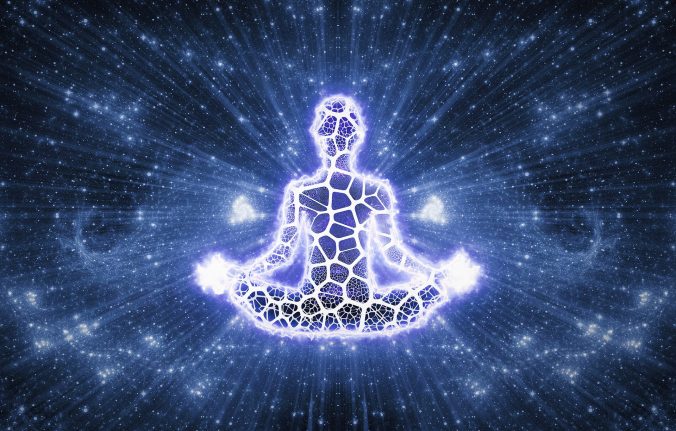Vipassana is the oldest of Buddhist meditation practices used for enhancing mindfulness. The method comes from the Satipatthana Sutta [Foundations of Mindfulness], a discourse attributed to the Buddha himself.
In Pali, an ancient language of Buddhism, the word ”Vipassana” means “seeing things as they really are.” The literal translation is “special seeing.”
Often, the term “Vipassana meditation” is used interchangeably with “mindfulness meditation,” but Vipassana is more specific. It involves observing your thoughts and emotions as they are, without judging or dwelling on them.
It’s different from other types of meditation techniques, like pranayama (breathing exercises) or visualization.
In these methods, you focus on a task or image. You actively train your mind and body to do something specific.
But in Vipassana, you simply observe your inner self instead of consciously controlling the experience.
The goal is to help you:
- quiet your mind
- focus on the present
- accept thoughts, emotions, and sensations for what they really are
- reduce regrets by dwelling less on the past
- worry less about the future
- respond to situations based on reality, instead of worries or preconceived notions
Benefits of Vipassana Meditation
Although there’s some research on the benefits of Vipassana for mental health and wellness, it hasn’t been as widely studied as other types of meditation.
However, research has found that Vipassana offers the following benefits:
Relieves stress
Vipassana, like other meditation techniques, can reduce our response to stress.
In a 2014 study, participants took part in a Vipassana meditation course. A 6-month follow-up found that the participants who took the course had lower self-reported stress levels than those who didn’t take the course.
According to the study, Vipassana participants also experienced increased:
- mindfulness
- self-kindness
- well-being
A small 2001 study found similar results after a 10-day Vipassana retreat.
Reduces anxiety
In addition to easing stress, Vipassana meditation may also help decrease anxiety.
In a small 2019 study, 14 participants completed a 40-day mindfulness meditation training that included Vipassana. Their anxiety and depression levels were lower after the training.
According to a 2013 review, mindfulness programs, including Vipassana meditation, may help alter parts of the brain involved in anxiety.
Improves mental wellness
The stress-relieving effects of Vipassana may improve other aspects of mental well-being.
A 2013 study of 36 individuals upon completing a 10-day Vipassana retreat found a significant increase in well-being and a possible, though inconclusive, improvement in heart function.
In a 2018 study of 520 individuals, those who practiced Vipassana reported higher levels of:
- self-acceptance
- competence
- engagement and growth
- positive relationships
However, it’s important to note this latter study was conducted as part of a research paper, and wasn’t published in a peer-reviewed journal.
Promotes brain plasticity
Practicing meditation, including Vipassana meditation, may help increase your brain plasticity.
Brain plasticity refers to your brain’s ability to restructure itself when it recognizes the need for change. In other words, your brain can create new pathways to improve mental functioning and well-being throughout your life.
A small 2018 study found that a regular Vipassana practice may help promote brain plasticity. The researchers came to this conclusion by using neuroimaging scans to examine the brain networks of Vipassana practitioners.
Helps treat addiction
An older 2006 study found that Vipassana meditation may benefit those with substance abuse. The researchers noted that the practice might be an alternative for conventional addiction treatments.
According to a 2018 review, mindfulness-based training programs with Vipassana components may improve such factors as self-control over habits, decision-making, and response inhibition, all of which are crucial to reducing drug use and maintaining abstinence.
Additionally, meditation can ease stress, a factor linked to substance use. More research is needed, however, to understand how Vipassana can manage addiction.
If you’re interested in trying Vipassana meditation at home, follow these steps:
- Set aside 10 to 15 minutes to practice. It’s recommended that you do Vipassana when you first wake up in the morning.
- Choose a quiet area with little to no distractions. An empty room or a secluded spot outside are great choices.
- Sit on the ground. Cross your legs in a comfortable position. Engage your core, straighten your back, and relax your body.
- Close your eyes and breathe normally. Focus on your natural breath and what you feel.
- Be mindful of each inhale and exhale. Observe your thoughts, feelings, and sensations without reacting or judging.
- If you become distracted, simply observe the distraction and return to your breath.
- Aim to do this for at least 5 to 10 minutes when you first start. As you get used to this practice, work up to 15 minutes or longer of Vipassana meditation.
Vipassana is an ancient mindfulness meditation technique. It involves observing your thoughts and emotions as they are, without judging or dwelling on them.
Though more studies are needed, research to date has found that Vipassana can reduce stress and anxiety, which may have benefits for substance use. It may also promote brain plasticity.
To get started with Vipassana, begin with 5- to 10-minute sessions in a quiet space. Slowly increase this to 15 minutes or longer as you get used to this form of meditation. You can also listen to audio recordings or attend a class for guided mediations.




Leave a Reply
You must be logged in to post a comment.